Zeju Qiu
Symbolic Graphics Programming with Large Language Models
Sep 05, 2025Abstract:Large language models (LLMs) excel at program synthesis, yet their ability to produce symbolic graphics programs (SGPs) that render into precise visual content remains underexplored. We study symbolic graphics programming, where the goal is to generate an SGP from a natural-language description. This task also serves as a lens into how LLMs understand the visual world by prompting them to generate images rendered from SGPs. Among various SGPs, our paper sticks to scalable vector graphics (SVGs). We begin by examining the extent to which LLMs can generate SGPs. To this end, we introduce SGP-GenBench, a comprehensive benchmark covering object fidelity, scene fidelity, and compositionality (attribute binding, spatial relations, numeracy). On SGP-GenBench, we discover that frontier proprietary models substantially outperform open-source models, and performance correlates well with general coding capabilities. Motivated by this gap, we aim to improve LLMs' ability to generate SGPs. We propose a reinforcement learning (RL) with verifiable rewards approach, where a format-validity gate ensures renderable SVG, and a cross-modal reward aligns text and the rendered image via strong vision encoders (e.g., SigLIP for text-image and DINO for image-image). Applied to Qwen-2.5-7B, our method substantially improves SVG generation quality and semantics, achieving performance on par with frontier systems. We further analyze training dynamics, showing that RL induces (i) finer decomposition of objects into controllable primitives and (ii) contextual details that improve scene coherence. Our results demonstrate that symbolic graphics programming offers a precise and interpretable lens on cross-modal grounding.
Orthogonal Finetuning Made Scalable
Jun 24, 2025Abstract:Orthogonal finetuning (OFT) offers highly parameter-efficient adaptation while preventing catastrophic forgetting, but its high runtime and memory demands limit practical deployment. We identify the core computational bottleneck in OFT as its weight-centric implementation, which relies on costly matrix-matrix multiplications with cubic complexity. To overcome this, we propose OFTv2, an input-centric reformulation that instead uses matrix-vector multiplications (i.e., matrix-free computation), reducing the computational cost to quadratic. We further introduce the Cayley-Neumann parameterization, an efficient orthogonal parameterization that approximates the matrix inversion in Cayley transform via a truncated Neumann series. These modifications allow OFTv2 to achieve up to 10x faster training and 3x lower GPU memory usage without compromising performance. In addition, we extend OFTv2 to support finetuning quantized foundation models and show that it outperforms the popular QLoRA in training stability, efficiency, and memory usage.
Reparameterized LLM Training via Orthogonal Equivalence Transformation
Jun 09, 2025Abstract:While large language models (LLMs) are driving the rapid advancement of artificial intelligence, effectively and reliably training these large models remains one of the field's most significant challenges. To address this challenge, we propose POET, a novel reParameterized training algorithm that uses Orthogonal Equivalence Transformation to optimize neurons. Specifically, POET reparameterizes each neuron with two learnable orthogonal matrices and a fixed random weight matrix. Because of its provable preservation of spectral properties of weight matrices, POET can stably optimize the objective function with improved generalization. We further develop efficient approximations that make POET flexible and scalable for training large-scale neural networks. Extensive experiments validate the effectiveness and scalability of POET in training LLMs.
Can Large Language Models Understand Symbolic Graphics Programs?
Aug 15, 2024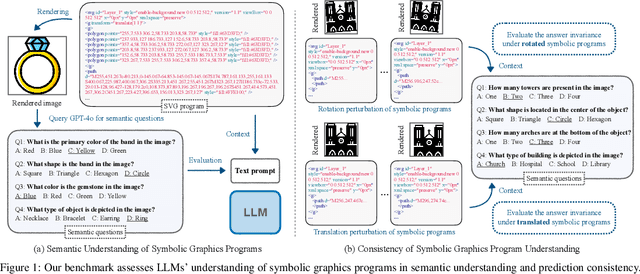

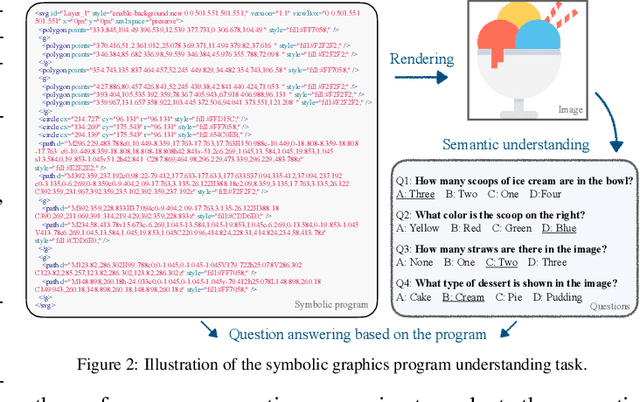
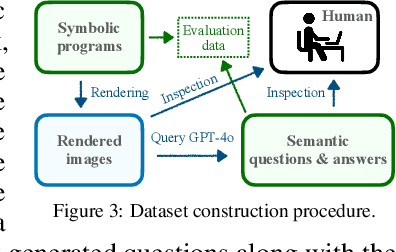
Abstract:Assessing the capabilities of large language models (LLMs) is often challenging, in part, because it is hard to find tasks to which they have not been exposed during training. We take one step to address this challenge by turning to a new task: focusing on symbolic graphics programs, which are a popular representation for graphics content that procedurally generates visual data. LLMs have shown exciting promise towards program synthesis, but do they understand symbolic graphics programs? Unlike conventional programs, symbolic graphics programs can be translated to graphics content. Here, we characterize an LLM's understanding of symbolic programs in terms of their ability to answer questions related to the graphics content. This task is challenging as the questions are difficult to answer from the symbolic programs alone -- yet, they would be easy to answer from the corresponding graphics content as we verify through a human experiment. To understand symbolic programs, LLMs may need to possess the ability to imagine how the corresponding graphics content would look without directly accessing the rendered visual content. We use this task to evaluate LLMs by creating a large benchmark for the semantic understanding of symbolic graphics programs. This benchmark is built via program-graphics correspondence, hence requiring minimal human efforts. We evaluate current LLMs on our benchmark to elucidate a preliminary assessment of their ability to reason about visual scenes from programs. We find that this task distinguishes existing LLMs and models considered good at reasoning perform better. Lastly, we introduce Symbolic Instruction Tuning (SIT) to improve this ability. Specifically, we query GPT4-o with questions and images generated by symbolic programs. Such data are then used to finetune an LLM. We also find that SIT data can improve the general instruction following ability of LLMs.
Parameter-Efficient Orthogonal Finetuning via Butterfly Factorization
Nov 10, 2023
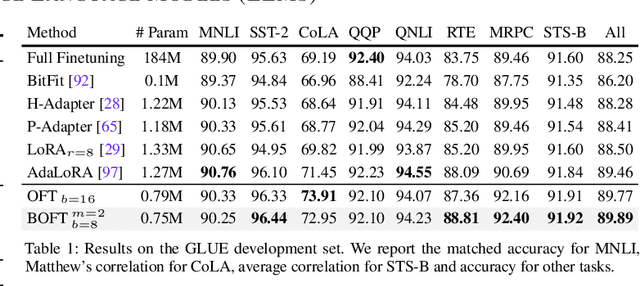
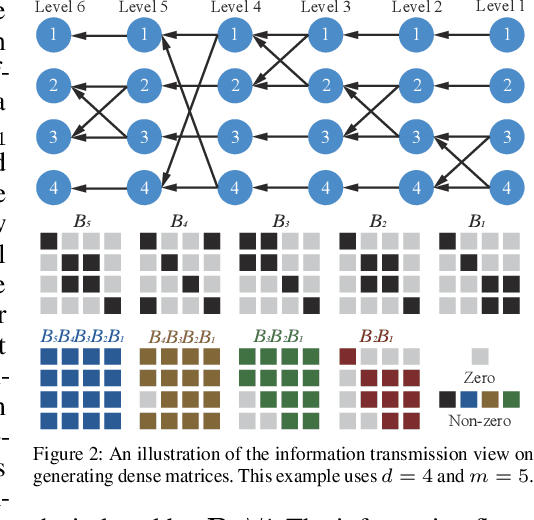
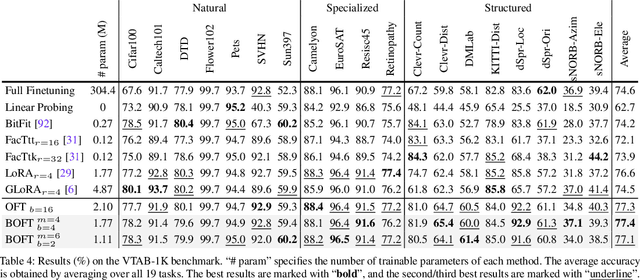
Abstract:Large foundation models are becoming ubiquitous, but training them from scratch is prohibitively expensive. Thus, efficiently adapting these powerful models to downstream tasks is increasingly important. In this paper, we study a principled finetuning paradigm -- Orthogonal Finetuning (OFT) -- for downstream task adaptation. Despite demonstrating good generalizability, OFT still uses a fairly large number of trainable parameters due to the high dimensionality of orthogonal matrices. To address this, we start by examining OFT from an information transmission perspective, and then identify a few key desiderata that enable better parameter-efficiency. Inspired by how the Cooley-Tukey fast Fourier transform algorithm enables efficient information transmission, we propose an efficient orthogonal parameterization using butterfly structures. We apply this parameterization to OFT, creating a novel parameter-efficient finetuning method, called Orthogonal Butterfly (BOFT). By subsuming OFT as a special case, BOFT introduces a generalized orthogonal finetuning framework. Finally, we conduct an extensive empirical study of adapting large vision transformers, large language models, and text-to-image diffusion models to various downstream tasks in vision and language.
Controlling Text-to-Image Diffusion by Orthogonal Finetuning
Jun 12, 2023Abstract:Large text-to-image diffusion models have impressive capabilities in generating photorealistic images from text prompts. How to effectively guide or control these powerful models to perform different downstream tasks becomes an important open problem. To tackle this challenge, we introduce a principled finetuning method -- Orthogonal Finetuning (OFT), for adapting text-to-image diffusion models to downstream tasks. Unlike existing methods, OFT can provably preserve hyperspherical energy which characterizes the pairwise neuron relationship on the unit hypersphere. We find that this property is crucial for preserving the semantic generation ability of text-to-image diffusion models. To improve finetuning stability, we further propose Constrained Orthogonal Finetuning (COFT) which imposes an additional radius constraint to the hypersphere. Specifically, we consider two important finetuning text-to-image tasks: subject-driven generation where the goal is to generate subject-specific images given a few images of a subject and a text prompt, and controllable generation where the goal is to enable the model to take in additional control signals. We empirically show that our OFT framework outperforms existing methods in generation quality and convergence speed.
Iterative Teaching by Data Hallucination
Oct 31, 2022



Abstract:We consider the problem of iterative machine teaching, where a teacher sequentially provides examples based on the status of a learner under a discrete input space (i.e., a pool of finite samples), which greatly limits the teacher's capability. To address this issue, we study iterative teaching under a continuous input space where the input example (i.e., image) can be either generated by solving an optimization problem or drawn directly from a continuous distribution. Specifically, we propose data hallucination teaching (DHT) where the teacher can generate input data intelligently based on labels, the learner's status and the target concept. We study a number of challenging teaching setups (e.g., linear/neural learners in omniscient and black-box settings). Extensive empirical results verify the effectiveness of DHT.
3D Multi-Object Tracking with Differentiable Pose Estimation
Jun 28, 2022



Abstract:We propose a novel approach for joint 3D multi-object tracking and reconstruction from RGB-D sequences in indoor environments. To this end, we detect and reconstruct objects in each frame while predicting dense correspondences mappings into a normalized object space. We leverage those correspondences to inform a graph neural network to solve for the optimal, temporally-consistent 7-DoF pose trajectories of all objects. The novelty of our method is two-fold: first, we propose a new graph-based approach for differentiable pose estimation over time to learn optimal pose trajectories; second, we present a joint formulation of reconstruction and pose estimation along the time axis for robust and geometrically consistent multi-object tracking. In order to validate our approach, we introduce a new synthetic dataset comprising 2381 unique indoor sequences with a total of 60k rendered RGB-D images for multi-object tracking with moving objects and camera positions derived from the synthetic 3D-FRONT dataset. We demonstrate that our method improves the accumulated MOTA score for all test sequences by 24.8% over existing state-of-the-art methods. In several ablations on synthetic and real-world sequences, we show that our graph-based, fully end-to-end-learnable approach yields a significant boost in tracking performance.
 Add to Chrome
Add to Chrome Add to Firefox
Add to Firefox Add to Edge
Add to Edge